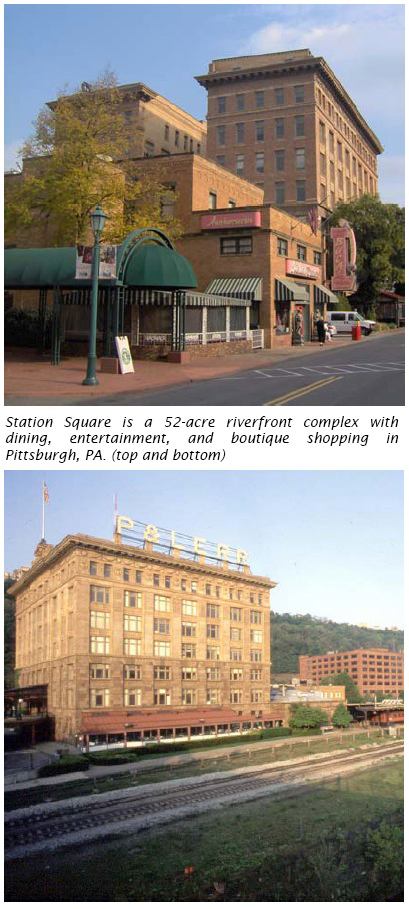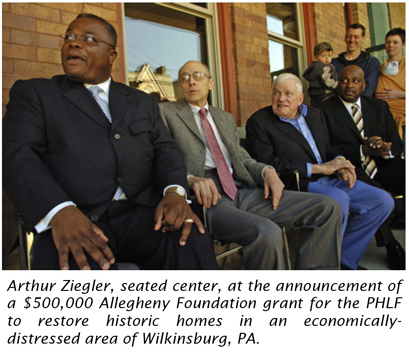
Arthur P. Ziegler, Master Preservationist
 Historic Preservation Planning Alumni, Cornell University
Historic Preservation Planning Alumni, Cornell University
Ithaca, New York
By Nathaniel C. Guest
June 9, 2009
“If you want to know preservation, follow Arthur Ziegler around for a few hours.”
This is what a friend from the National Trust told me a little while back. And in a rare bit of serendipity, I did.
On April 10, 2009, Arthur Ziegler, a living legend in the preservation world, addressed the next generation of preservationists and planners at Cornell University. Taking advantage of a rare bit of Ithaca sunshine, I offered Mr. Ziegler the five-cent-tour of the campus during the hour before his lecture. His visit would coincide with “Cornell Sustainability Month,” and the university was littered with advertisements for “eco” this and “green” that.
Now, please don’t read anything into my tone; as a proud Cornellian, I have to say we do a fairly good job at being critical about what is sustainable and what is just clever marketing. That said, the rest of the world has set the bar rather low for us. I’ve always thought it a bit ironic that in a culture as consumptive as ours that the word “sustainable” should be much a part of the popular lexicon.
Offering a lecture entitled “Pittsburgh as People and Place,” Mr. Ziegler didn’t come to Cornell to address sustainability. Whether he intended it or not, though, he hit it head-on.
A dean in the art and science of saving places, Arthur’s work has proceeded with the understanding that any plan or policy that is ultimately successful—that is, “sustainable” beyond the buzzword—is by necessity not just ecologically conscious but equally importantly socially just and economically responsible.
As Mr. Zielger has shown, these principles are not roadblocks but stepping stones. Using them, he has led his Pittsburgh History and Landmarks Foundation from an inauspicious start—a slide projector, a brochure, and $750 in 1964—to a multi-million-dollar preservation powerhouse in 2009.
 Promoting historic preservation as an effective means to create affordable housing, healthy neighborhoods, and economic development, Mr. Ziegler founded the PHLF to combat urban renewal policies that literally and spiritually devastated much of Pittsburgh. Displacing thousands of residents over several decades, a “clear-cutting” renewal policy in the era before the PHLF left Pittsburgh one of the most segregated cities in America.
Promoting historic preservation as an effective means to create affordable housing, healthy neighborhoods, and economic development, Mr. Ziegler founded the PHLF to combat urban renewal policies that literally and spiritually devastated much of Pittsburgh. Displacing thousands of residents over several decades, a “clear-cutting” renewal policy in the era before the PHLF left Pittsburgh one of the most segregated cities in America.
Through the PHLF, Ziegler spearheaded the first urban renewal program in the nation that used urban development monies for preservation rather than demolition. PHLF’s Manchester neighborhood project was the first urban renewal project to create a preservation district within a predominantly African-American neighborhood and the first to be administered by the residents themselves.
It is unique in that it preserved the neighborhood both architecturally and culturally, simultaneously avoiding both further blight and gentrification. Indeed, Mr. Ziegler’s work has been as much about social justice for disenfranchised populations as it has been preserving important places.
 “To preserve an historic building is to save an artifact. To preserve an historic neighborhood is to save a way of living,” said Mark Fatla, executive director of Pittsburgh’s Northside Leadership Conference. “Arthur understood this far better than anyone else, and far sooner than anyone else. He has succeeded at it far longer than anyone else,” he continued.
“To preserve an historic building is to save an artifact. To preserve an historic neighborhood is to save a way of living,” said Mark Fatla, executive director of Pittsburgh’s Northside Leadership Conference. “Arthur understood this far better than anyone else, and far sooner than anyone else. He has succeeded at it far longer than anyone else,” he continued.
This is a crucial aspect to sustainability that mere “green building” absent historic preservation cannot accommodate. Just as we question the “greenness” of any building whose construction sends another building to a landfill, we must question the social justice of “revitalization” that razes neighborhoods or displaces its residents.
The upheaval and social disorder following in the wake of Pittsburgh’s urban renewal suggest that the sort of “root shock” caused by aggressive demolition in minority neighborhoods should be every bit as distressing to planners as the targeting of such neighborhoods for locally unwanted land uses.
Insensitive re-development makes even less sense when, as Mr. Ziegler’s work has shown, preservation is a smarter economic bet in the long run. Emblematic of PHLF’s success in using historic preservation as an instrument of economic revitalization, its adaptive re-use of a former rail terminal facility at Station Square had the lowest public cost and highest taxpayer return of any major renewal project in the Pittsburgh region since the 1950s. With over three million visitors each year, Station Square generates over six million dollars annually in tax revenue.
“Arthur always keeps his eye on what will work for the people of a place and what PHLF can bring to assist them. This is the beginning of his secret, “said Peter Brink of the National Trust for Historic Preservation.
I thank Mr. Ziegler for sharing a bit more of that secret with us.
